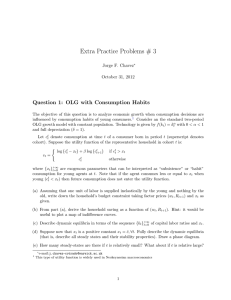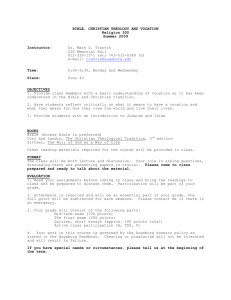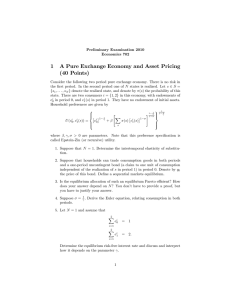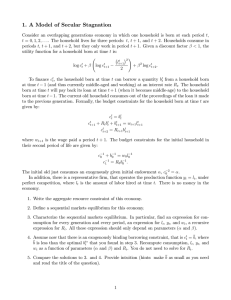Document 13567371
advertisement
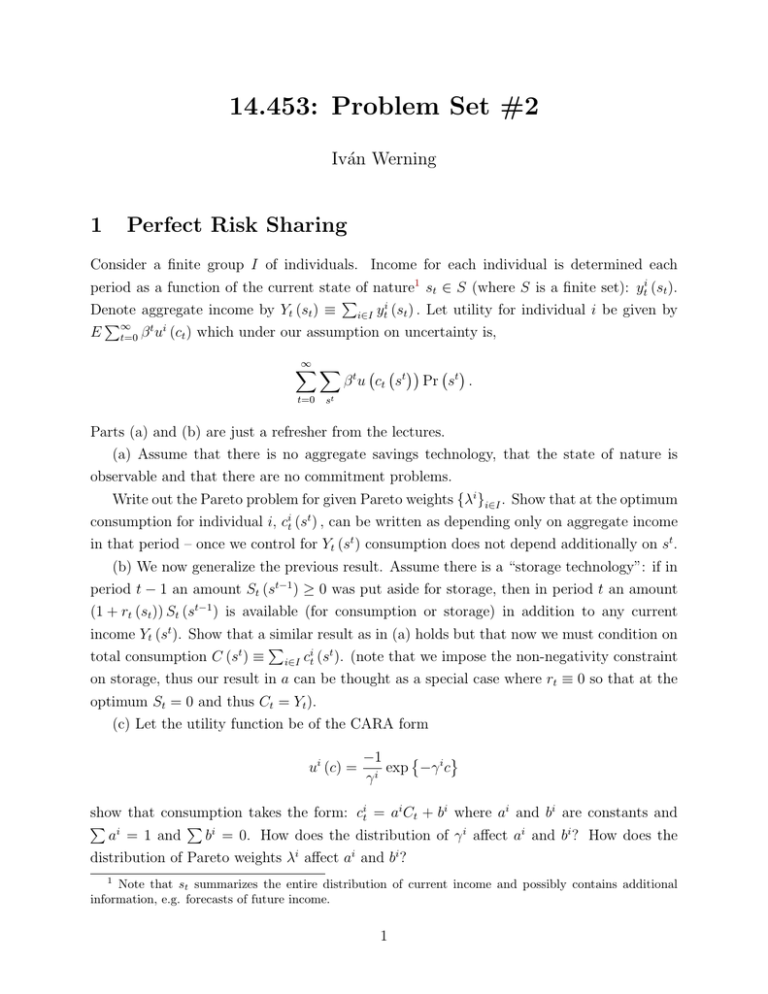
14.453: Problem Set #2
Iván Werning
1
Perfect Risk Sharing
Consider a finite group I of individuals. Income for each individual is determined each
period as a function of the current state of nature1 st ∈ S (where S is a finite set): yti (st ).
�
Denote aggregate income by Yt (st ) ≡ i∈I yti (st ) . Let utility for individual i be given by
�
t i
E ∞
t=0 β u (ct ) which under our assumption on uncertainty is,
∞ �
�
t=0
st
� � �� � �
β t u ct st Pr st .
Parts (a) and (b) are just a refresher from the lectures.
(a) Assume that there is no aggregate savings technology, that the state of nature is
observable and that there are no commitment problems.
Write out the Pareto problem for given Pareto weights {λi }i∈I . Show that at the optimum
consumption for individual i, cit (st ) , can be written as depending only on aggregate income
in that period – once we control for Yt (st ) consumption does not depend additionally on st .
(b) We now generalize the previous result. Assume there is a “storage technology”: if in
period t − 1 an amount St (st−1 ) ≥ 0 was put aside for storage, then in period t an amount
(1 + rt (st )) St (st−1 ) is available (for consumption or storage) in addition to any current
income Yt (st ). Show that a similar result as in (a) holds but that now we must condition on
�
total consumption C (st ) ≡ i∈I cit (st ). (note that we impose the non-negativity constraint
on storage, thus our result in a can be thought as a special case where rt ≡ 0 so that at the
optimum St = 0 and thus Ct = Yt ).
(c) Let the utility function be of the CARA form
ui (c) =
� i �
−1
exp
−γ c
γi
show that consumption takes the form: cit = ai Ct + bi where ai and bi are constants and
� i
� i
a = 1 and
b = 0. How does the distribution of γ i affect ai and bi ? How does the
distribution of Pareto weights λi affect ai and bi ?
1
Note that st summarizes the entire distribution of current income and possibly contains additional
information, e.g. forecasts of future income.
1
(d) Let the utility function be of the CRRA form
c1−σ
u (c) =
1−σ
i
where the risk aversion σ is assumed to be the same for all individuals. Show that consump­
�
tion takes the form cit = αi Ct with the constants αi satisfying i∈I αi = 1. How do the
constants αi depend on the Pareto weights λi ?
2
Risk Sharing Productivity: Consumption and Labor
Consider a social planner who maximizes the utility of a continuum of agents of measure
one ex-ante identical, with preferences over consumption and leisure
u (c, l)
where we assume that utility function u (.) is strictly concave, continuously differentiable
and increasing in both its arguments.
Agents are heterogeneous ex-post according to their productivity. They draw one non­
negative productivity parameter ω ∈ Ω independently from a known continuous distribution
function F . We assume that the support Ω = [ωmin , ωmax ] is compact and the density function
density function f (ω) is bounded above and bounded away from zero.
The resource constraint in this economy is
�
c(ω)f (ω)dω ≤
�
(1 − l(ω))ωf (ω)dω + e
for some endowment e ≥ 0.
Let us assume that agents’ productivity is ex-post publicly observable, so that consump­
tion and leisure can be conditioned on their ability, i.e. c (ω) and l (ω).
(a) Write down the social planner problem, noting that, given that the agents are a
continuum of measure one, by the law of large number, the ex-ante probability coincides
with the ex-post distribution.
(b) Show that, under the given assumptions, leisure is a decreasing function of the pro­
ductivity parameter ω. Discuss.
(c) Show that the dependence of consumption on the productivity parameters depends on
2 u(.)
the assumption on the sign of the cross-derivative ucl (short notation for ∂∂c∂l
). Comment.
(d) Show that assuming that leisure is a normal good is sufficient (for any sign of ucl ) to
have the utility function decreasing in the productivity. Discuss the role of risk sharing.
2
(e) Assume now that agents’ productivity is not ex-post observable anymore. Given your
result in the previous point, is the previous allocation implementable? Comment.
3
Overlapping Generations
In this problem we study an overlapping generations model under two market interpretations
and isolate the conditions for Pareto optimality.
All individuals live for only two periods. Generation t (denoted by the superscript) has
utility function:
� �
�
�
u ctt + βu ctt+1
where u : R+ → R is strictly concave and increasing in the single consumption good c.
Individuals are endowed with one unit of labor in the first period of their lives and supply
it inelastically. Capital is owned by individuals and rented out to firms. Competitive firms
rent capital and labor at prices rt and wt (in terms of time t consumption goods). At time
zero all initial capital is held by the old (i.e. generation t = −1).
The resource constraint is,
kt+1 + ctt + ct−1
≤ F (kt , 1) + (1 − δ) kt ,
t
where F is a constant returns to scale (CRS) production function and δ ∈ (0, 1].
(a) Sequential Trade. Consider the sequential competitive market arrangement where
individuals in generation t face the budget constraints,
ctt + kt+1 = wt
ctt+1 = Rt+1 kt+1
with Rt ≡ (1 − δ + rt ).
��
�
�∞
Given k0 , define a competitive equilibrium for this market arrangement for c0t , ctt , ctt+1 , kt+1 t=0
and prices {rt , wt }∞
t=0 .
(b) Time-0 trade. Now consider the complete market arrangement where we imagine all
generations (the born and yet unborn) and firms meeting at time zero and competitively
trading in claims for future consumption, labor and capital. We generalize the notation and
specialize it to interpret our overlapping generations model.
3
Generation t faces the budget constraint:
∞
�
s=0
qs0
∞
� t
� �
t
t
cs + ks+1 − Rs ks ≤
qs0 ws n̄ts + R0 k̄0t
s=0
where we have normalize q00 = 1 and Rs is as before.
Notation: n̄ts and k̄0t represent endowment of labor in period s and initial capital owned
by generation t. Thus, in our OLG model: nst = 1 for s = t and nst = 0 for s 6= t; k̄0−1 = k0
and k̄0s = 0 for s =
6 −1.
Think of each generation-t as having a utility function U t defined over the entire con-
�
�
∞
∞
sumption stream {cts }s=0 . Of course, in our OLG model: U t ({cts }s=0 ) ≡ u (ctt ) + βu ct
t+1 .
�
�∞
��
∞
Define an equilibrium for c0t , ctt , ctt+1 , kt+1 t=0 and prices {qt0 }t=0 and {rt , wt }∞
t=0 using
the standard Walrasian setup.
Show that equilibria must satisfy the arbitrage condition: qt0 /qt0+1 = Rt+1 . Argue that
the sequential market equilibrium in part (a) is a time-0 market equilibrium, as outlined
here, for appropriately chosen prices {qt0 }.
(c) Consider the special case of log utility, u (c) = log c, and Cobb-Douglas production
��
�
�∞
function F (nt , kt ) = Aktα n1t −α . Characterize the entire equilibrium allocation c0t , ctt , ctt+1 , kt+1 t=0
and prices {rt , wt }∞
t=0 . Solve for the steady state level of capital kss .
Show that the equilibrium is not Pareto efficient if steady state capital higher than the
golden rule kg = arg maxk {F (k, 1) − δk}. Show that there are parameters values for which
kg < kss .
(Hint: construct an allocation that increases everyone’s consumption for all periods t
high enough such that at the original equilibrium allocation capital remains higher than the
golden rule, i.e. ks > kg for s ≥ t).
(d) In terms of the time-0, complete-market arrangement. Why does the First Welfare
Theorem fail to apply? (Hint: argue that the condition
∞ �
∞
�
qt0 wt n̄st < ∞
s=0 t=0
is necessary for the proof of the first welfare theorem and that it is not satisfied here). Show
that the welfare theorem does apply if kss ≤ kg .
(e) The previous points show that if kss ≤ kg then there are Pareto weights {λt } for
generations such that the equilibrium allocation maximizes:
∞
�
t=0
∞
� � t�
� t ��
� 0� �
�
� �
�
��
λt u ct + βu ct+1 + λ−1 βu c1 =
λt u ctt + λt−1 βu ctt−1
t=0
4
subject to ctt + ct−1
+ kt+1 ≤ F (kt , 1) + (1 − δ) kt .
t
Show that if k0 = kss then λt /λt−1 = α for some α < 1.
(f) Show that,
U (C) ≡ max [αu (cy ) + βu (co )] = φu (C)
s.t. cy + co = C
for some φ > 0.
Use this and the results above to show that when kss ≤ kg the equilibrium allocation
with k0 = kss solves the representative agent problem,
max′
C,k
∞
�
αt u(Ct )
t=0
subject to, Ct + kt+1 ≤ F (kt , 1) + (1 − δ) kt and k0 = kss .
How does α compare to β?
5
